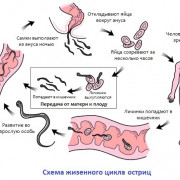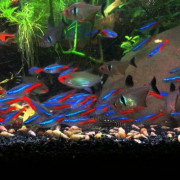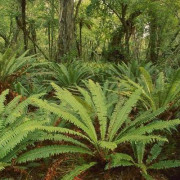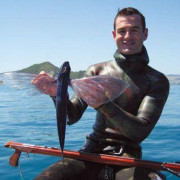Mosasaurus
Содержание:
About Mosasaurus
The remains of Mosasaurus were discovered well before educated society knew anything about evolution, dinosaurs, or marine reptiles—in a mine in Holland in the late 18th century (hence this creature’s name, in honor of the nearby Meuse River). Importantly, the unearthing of these fossils led early naturalists like Georges Cuvier to speculate, for the first time, about the possibility of species going extinct, which flew in the face of accepted religious dogma of the time. (Until the late Enlightenment, most educated people believed that God created all the world’s animals in Biblical times and that the exact same animals existed 5,000 years ago as do today. Did we mention that they also had no conception of deep geologic time?) These fossils were variously interpreted as belonging to fish, whales, and even crocodiles; the closest guess (by the Dutch naturalist Adriaan Camper) was that they were giant monitor lizards.
It was Georges Cuvier who established that the fearsome Mosasaurus was a giant member of the family of marine reptiles known as mosasaurs, which were characterized by their large heads, powerful jaws, streamlined bodies, and hydrodynamic front and rear flippers. Mosasaurs were only distantly related to the pliosaurs and plesiosaurs (sea serpents) that preceded them (and which they largely supplanted from the dominance of the world’s oceans during the late Cretaceous period). Today, evolutionary biologists believe they were most closely related to modern-day snakes and monitor lizards. The mosasaurs themselves went extinct 65 million years ago, along with their dinosaur and pterosaur cousins, by which time they may already have been succumbing to competition from better-adapted sharks.
As with many animals that have lent their names to entire families, we know comparatively less about Mosasaurus than we do about better-attested mosasaurs like Plotosaurus and Tylosaurus. The early confusion about this marine reptile is reflected in the various genera to which it was assigned in the course of the 19th century, including (take a deep breath) Batrachiosaurus, Batrachotherium, Drepanodon, Lesticodus, Baseodon, Nectoportheus, and Pterycollosaurus. There have also been close to 20 named species of Mosasaurus, which gradually fell by the wayside as their fossil specimens were assigned to other mosasaur genera; today, all that remain are the type species, M. hoffmanni, and four others.
By the way, that shark-swallowing Mosasaurus in the movie «Jurassic World» may seem impressive (both to people in the fictional park and people in the real-life movie-theater audience), but it’s completely out of scale: A real, 15-ton Mosasaurus would have been an order of magnitude smaller and much less impressive than its cinematic depiction—and almost certainly incapable of dragging a gigantic Indominus rex into the water.
Систематика
Мозазавр Гоффмана — вид рода подсемейства Mosasaurinae, семейства и надсемейства Mosasauroidae. Ряд исследователей также выделяют продвинутую кладу Mosasaurini внутри подсемейства, и относят к ней мозазавра Гоффмана и ряд других поздних представителей подсемейства, более продвинутых, чем большинство представителей парафилетического рода . В настоящее время считается, что описанные таксоны Mosasaurus camperi, M. dekayi, M. giganteus и M. maximus являются синонимами M. hoffmanni. Mosasaurus lemonnieri может быть молодой особью данного вида.
Кладограмма подсемейства от Д. В. Григорьева, 2013:
| Mosasaurinae |
|
|||||||||||||||||||||||||||||||||||||||||||||||||||||||||||||||||||||||||||||||||||||||||||||||||||
Последнее филогенетическое исследование от Simões et al. (2017) помещает M. hoffmanni ближе к , чем к другим видам, традиционно относимым к роду Mosasaurus:
| Mosasaurinae |
|
||||||||||||||||||||||||||||||||||||||||||||||||||||||||||||||||||||||||||||||||||||||||||||||||
Ссылки
Коэффициент силы укуса (англ. bite force quotient, BFQ) — безразмерный относительный показатель, характеризующий действительную силу укуса животного относительно силы, ожидаемой для животного с той же массой тела. Вычисляется с помощью специальной формулы.
Значение ожидаемой силы укуса, учитывающее только массу тела и не учитывающее особенностей телосложения и физиологии животного, определяется с использованием коэффициентов, подобранных методом регрессионного анализа для достаточно большой выборки видов. Как правило, выборка видов ограничена достаточно распространёнными хищными видами: например, в работе Роу, Макхенри и Томасона обобщены показатели 32 видов и подвидов, в том числе 11 кошачьих и 11 псовых. Значение действительной силы укуса обычно очень сложно измерить непосредственно, поэтому под действительной силой укуса понимается расчётная величина, зависящая от геометрических размеров челюстей и приводящих их в движение мышц. Расчётная величина как правило меньше реальной силы укуса животных, но вполне позволяет сравнивать их между собой. Если действительная сила укуса равна ожидаемой для данной массы тела, то коэффициент силы укуса приравнивается к 100. По данным Роу, Макхенри и Томасона, такой коэффициент имеют американская рыжая рысь и новогвинейская поющая собака. Отклонения действительной силы вверх от ожидаемого значения характеризуются значениями коэффициента, большими 100, отклонения вниз — коэффициентами, меньшими 100.
Сумчатые хищники имеют, как правило, бо́льший коэффициент, чем плацентарные: коэффициенты трёх исследованных видов сумчатых куниц равны 137, 179 и 181, коэффициент сумчатого волка равен 166, а сумчатого дьявола — 181. Роу, Макхенри и Томасон объясняют это явление различным строением черепа: ме́ньший объём головного мозга хищных сумчатых позволяет им иметь при той же массе тела более эффективные челюсти. Выпадающая из «сумчатого ряда» крапчатая сумчатая куница, имеющая относительно низкий К=137, ведёт не хищный, а всеядный образ жизни. Точно такой же коэффициент имеет чисто плотоядный и нападающий на крупную добычу ягуар, а у охотящийся на мелкую добычу кошки он вдвое меньше (K=58).
Тилозавры (лат. Tylosaurus от др.-греч. τύλος «деревянный гвоздь, шип» и σαῦρος «ящерица») — род гигантских мозазавров мелового периода. Одни из самых известных и крупных мозазавров. Род описан Г. Ч. Маршем в 1872 году; название выбрано, вероятно, из-за вытянутого рыла. Интересно, что типовой вид был описан в 1869 году Э. Д. Коупом, соперником Марша, из отложений Канзасского Мелового моря. Но Коуп отнёс животное к роду Macrosaurus, а это название было уже «занято». Позднее он же отнёс типовой образец к малоизвестному европейскому роду Liodon. Остатки тилозавров широко распространены в отложениях позднего мела США, поэтому их описывали под самыми разными названиями (Rhamphosaurus, Rhinosaurus).
Примечания
- . fossilworks.org. Дата обращения 24 июня 2019.
- ↑
- ↑ Russell, D.A. 1967. Systematics and morphology of American mosasaurs. Peabody Museum of Natural History, Yale University, Bulletin 23.
- ↑ . www.prehistoric-wildlife.com. Дата обращения 14 января 2016.
- ↑
- ↑ (англ.). Дата обращения 31 октября 2018.
- ↑
- ↑ Johan Lindgren, John W. M. Jagt, Michael W. Caldwell, (2007), A fishy mosasaur: the axial skeleton of Plotosaurus (Reptilia, Squamata) reassessed.
- ↑ Jesse A. Carpenter (2017), Locomotion and skeletal morphology of Late Cretaceous mosasaur, Tylosaurus proriger.
- ↑ Anne S. Schulp, Geert H.I.M. Walenkamp, Paul A.M. Hofman4, Yvonne Stuip5 & Bruce M. Rothschild, 2006. Chronic bone infection in the jaw of Mosasaurus hoffmanni (Squamata).
- ↑ . ResearchGate. Дата обращения 21 января 2016.
- ↑
- Johan Lindgren, Michael W. Caldwell and John W. M. Jagt (2008), New Data on the Postcranial Anatomy of the California Mosasaur Plotosaurus bennisoni (Camp,1942) (Upper Cretaceous: Maastrichtian), and the Taxonomic Status of P. tuckeri (Camp, 1942).
- Aaron R. H. Leblanc, Michael W. Caldwell and Nathalie Bardet (2012). «A new mosasaurine from the Maastrichtian (Upper Cretaceous) phosphates of Morocco and its implications for mosasaurine systematics». Journal of Vertebrate Paleontology.
- Konishi, Takuya; Brinkman, Donald; Massare, Judy A.; Caldwell, Michael W. (2011-09-01). New exceptional specimens of Prognathodon overtoni (Squamata, Mosasauridae) from the upper Campanian of Alberta, Canada, and the systematics and ecology of the genus.
- L. Dollo. 1909. The fossil vertebrates of Belgium. Annals of the New York Academy of Science 19(4):99-119
- . DeviantArt. Дата обращения 16 октября 2017.
- Nathalie Bardet & Cemal Tunoğlu (2002). «The first mosasaur (Squamata) from the Late Cretaceous of Turkey». Journal of Vertebrate Paleontology 22 (3): 712—715. :10.1671/0272-4634(2002)0222.0.CO;2.
- ↑ . www.paleofile.com. Дата обращения 23 мая 2016.
- (англ.). www.geology.lu.se. Дата обращения 16 октября 2017.
- Физика невозможного / Митио Каку ; Пер. с англ. — 5-е изд. — М: Альпина нон-фикшн, 2014.
- ↑ Lingham-Soliar T.; Nolf D. (1989) The mosasaur Prognathodon (Reptilia, Mosasauridae) from the Upper Cretaceous of Belgium.
- ↑ Kiernan, Caitlin R. (2002). «Stratigraphic distribution and habitat segregation of mosasaurs in the Upper Cretaceous of western and central Alabama, with an historical review of Alabama mosasaur discoveries». Journal of Vertebrate Paleontology. 22 (1): 91–103.
- Halter, M.C. (1995) Additions to the Fish Fauna of N.W. Europe. 3. Three new species of the genus Scyliorhinus from the Late Cretaceous (Campanian and Maastrichtian) of the Limburg area (Belgium and The Netherlands) with a reassignment of four additional species to the genus Scyliorhinus sensu stricto. Belgian Geological Survey, Professional Paper: Elasmobranches et Stratigraphie, 278: 65–109, 12 fig., pl. 1–12.
- Halter, M.C. (1990) Additions to the fish fauna of N.W. Europe. 2. Two new species of Scyliorhinus from the Late Cretaceous (Maastrichtien) of the Limburg area (Belgium and The Netherlands). Mesozoic Research, 2 (4): 219–236, 6 fig., 3 pl.
- . oceansofkansas.com. Дата обращения 23 мая 2016.
- ↑
- ↑
- ↑
- . www.paleofile.com. Дата обращения 1 июня 2016.
- Evans, M. (2010). «The roles played by museums, collections and collectors in the early history of reptile palaeontology.» Pp. 5-31 in Moody, R.T.J., Buffetaut, E., Naish, D. and Martill, D.M. (eds.) Dinosaurs and Other Extinct Saurians: A Historical Perspective. Geological Society Special Publication 343.
- Camper, P. (1786). «Conjectures relative to the petrifactions found in St. Peter’s Mountain near Maestricht», Philosophical Transactions 76(2): (digitized version on Gallica).
- Faujas de Saint-Fond. Rompen, P. (1995). Mosasaurus hoffmanni: De lotgevallen van een type-exemplaar.
- M. van Marum. Beschrijving der beenderen van den kop van eenen visch, gevonden in den St Pietersberg bij Maastricht, en geplaatst in Teylers Museum // Verhandelingen Teylers Tweede Genootschap. — 1790. — Т. 9. — С. 383—389.
- AG Camper. Lettre de AG Camper à G. Cuvier sur les ossemens fossiles de la montagne de St. Pierre, à Maëstricht // Journal de Physique. — 1800. — № 51 (1800). — С. 278—291.
- (23 сентября 2012). Дата обращения 6 августа 2018.
- (26 Апрель 2015).










